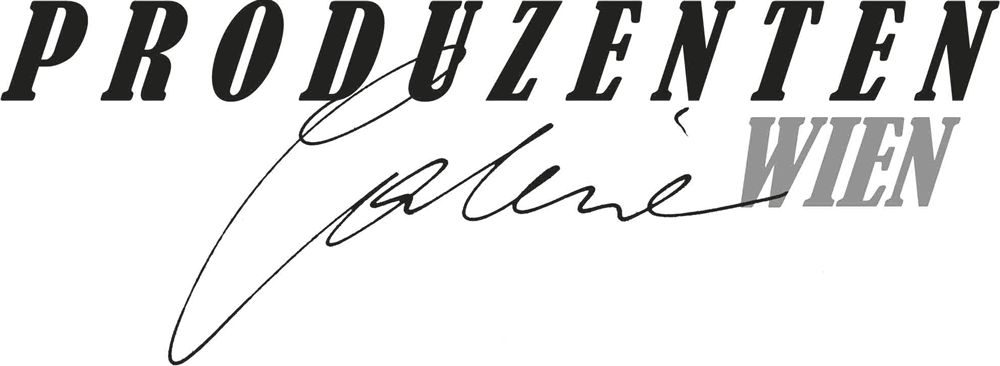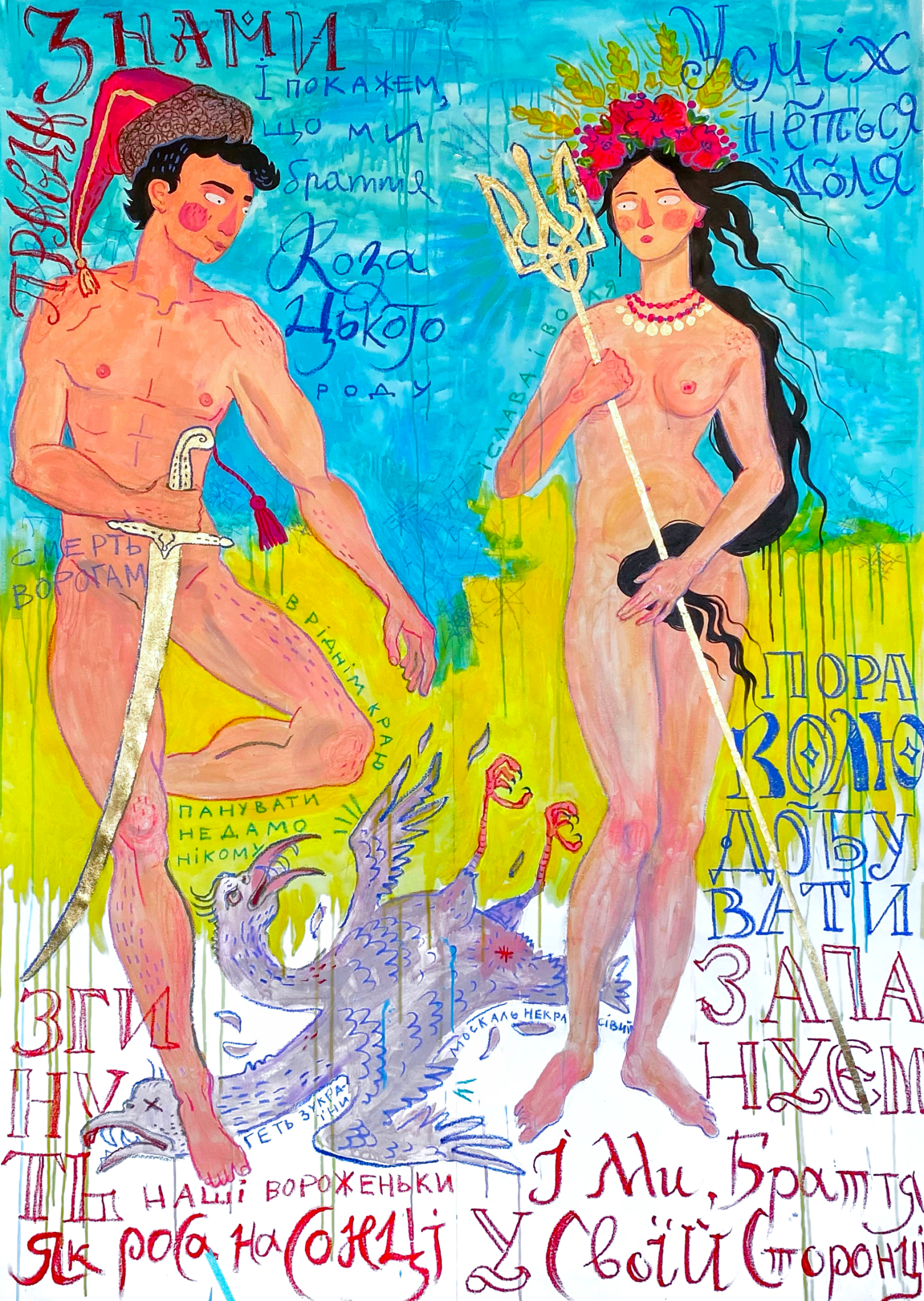Zur Podiumsdiskussion waren Martin Pollak, Historiker und Schriftsteller aus Wien und Alexander Filts, Vorstand des psychiatrischen Institutes der Universität Lviv eingeladen.
Die ausgestellten Arbeiten reichen von der Darstellung kämpferischer Kossaken, über ein junges Paar als Hoffnungsträger einer neuen Zukunft nach all den Flammen und Trümmern, bis hin zu gottesgläubigen Darstellungen, aber auch Fotokunst zum Thema Krieg, Zerstörung und Hoffnung.
In der Podiumsdiskussion wurde als erstes die Rolle der Kunst im Krieg bearbeitet. Martin Pollack zitierte historische Vergleiche mit Kunstwerken zum Krieg, wie Picassos Guernica, Munchs Schreie aber auch Adornos Zitat „nach Auschwitz ist keine Kunst möglich“.
Vielleicht müsste man auch Imre Kertész hinzufügen mit der einer neuen Sprache der Kälte hergeleitet von Camus und Kierkegaard.
Alle ausgestellten Kunstwerke sind während und nach der Flucht aus der Ukraine nach Wien entstanden, teilweise auf den Korridoren der Hotels in denen die Familien übernachteten.
Alexander Filts beschrieb eine weitere Rolle der Kunst im Krieg. Dieser Krieg sei so irrational, so völlig dem logischen Denken entzogen, dass die Kunst eher einen Zugang zur Erklärung finden könnte, immerhin sei der Präsident der Ukraine auch ein Künstler. Dieser Argumentation des Irrationalen verwahrte sich Martin Pollack, denn politisches Handeln hat immer, je nach Interessenslage der Handelnden, seine eigene Logik.
Dann gab es die Frage aus dem Publikum, wie die Zukunft aussehen könnte. Martin Pollack antwortete, es gäbe nur eine Möglichkeit, die Vernichtung der russischen Armee.
Schließlich stellte ich die Frage, ob nicht rückblickend gesehen die europäische Gemeinschaft und die NATO auch große Fehler gemacht hätten aus denen zu lernen ist, indem nämlich die NATO einen Beitrittsantrag der Russen in den 90er Jahren ablehnte und die EU, vor allem einzelne Staaten wie England, Schweden und Litauen massive Versprechungen anboten, die nie einzuhalten waren und dadurch die ukrainische Bevölkerung regelrecht täuschte. Diese Analyse wurde aber von Rednern in der Folge abgelehnt.
Zum Abschluss meinte Prof. Filts, dass wir uns bewusst sein sollten, dass diese Ausstellung und auch diese Diskussion ein historisches Ereignis ist. Nicht wie normale Ausstellungen wiederholbar, sondern sie ist ein historisch einmaliges Ereignis, ein Dokument für die Zukunft.
Liste aller teilnehmenden Künstler*innen:
Sofiia Boztnikova Liza Martyniuk Alisa Husieva Inna Nikolaieva
Oksana Sergienko Nastia Kozlova Mariya Chorna Vasily Mishchenko
In unserem wöchentlichen Videoblog zeigen berichten wir auch über unsere aktuelle Ausstellung und die vergangene Podiumsdiskussion:
Produzentengalerie Wien
Marc Aurel Straße 10 | 1010 Wien www.produzentengalerie.wien office@produzentengalerie.wien
An exhibition in the Produzentengalerie Wien of works by Ukrainian artists fleeing the war
During the plenary discussion Martin Pollak, historian and writer from Vienna, and Alexander Filts, head of the Psychiatric Institute of the University of Lviv, were invited to comment.
The works on display range from depictions of militant Crossacks, to a young couple as bearers of hope for a new future after flames and rubble, to representations of believe in God, but also photographic art on the subject of war, destruction and hope.
The first part of the panel discussion focused on the role of art during war. Martin Pollack showed historical comparisons with works of art on war, such as Picasso’s Guernica, Munch’s Scream, but also Adorno’s quote “after Auschwitz, no art is possible.”
Perhaps one should also add Imre Kertézs with a new language of coldness derived from Camus and Kierkegaard.
All the exhibitied works of art were created during and after the flight from Ukraine to Vienna, some of the corridors of hotels where the families stayed.
Alexander Filts presented another role of art during war. This was is so irrational, so completely deprived of logical thinking, that art would be more likely to explain it, after all the president of Ukraine is an artist too.
Martin Pollack opposed this argument of the irrational, because political action always has its own logic, depending on the interest of the actors.
Then there was a question from the audience about what the future might look like. Martin Pollack replied that there was only one option, the annihilation of the Russian army.
Finally, I asked the question, if – when looking back – the European Community and NATO had made big mistakes as well, namely in that NATO rejected a Russian application for membership in the 1990s and the EU, above all individual states such as England, Sweden, and Lithuania offered massive promises that could never be kekpt, thereby deceiving the Ukrainian population. However, this analysis was subsequently rejected by speakers.
In conclusion, Prof. Filts said that we should be aware that this exhibition and also this discussion cannot be repeated like a normal exhibition. It is a historically unique event, a document for the future.
Participating artists:
Sofiia Boztnikova Liza Martyniuk Alisa Husieva Inna Nikolaieva
Oksana Sergienko Nastia Kozlova Mariya Chorna Vasily Mishchenko
In our weekly video blog you can see more about our actual exhibition as well as past plenary discussions:
ANNEX:
Sofiia Bortnikova
“Love will have your back” Mixed media on canvas 120x160cm
1.500,-
This painting was inspired by “The Kiss” by Gustav Klimt.
The sky is clear and blue, young girl is standing barefoot on the first spring grass. She is kissing the soldier in goodbye. He is shielding her peaceful world with his own body, protecting his loved one and his homeland from horrible, ugly war.
The girls dress and skin are light and airy, almost blending with the nature of the background. I wanted to show how fragile and gentle this world is in contrast to brutal, loud and cruel war.
On the left side you can also see the Ukrainian traditional ornament called “The tree of life”.
The tree of life does not cease to bloom, so the crown is always decorated with lush flowers. Some of them have already faded, some have just blossomed, others are waiting for their time in the buds. Each of the flowers is a variety of stages of human life. Ripe fruits symbolize the results of human actions and deeds, and the buds – the future generation. The top of the Tree is usually decorated with a flower – „Fire of Life“. Next to it are two bright guardian spirits in the form of birds, sometimes „birds of paradise“ can be depicted at the bottom of the trunk. They symbolize the soul of the universe. Traditionally, a tree is depicted as growing in a vase, a bowl, coming out of it, so its roots are strengthened and grow from the bosom of the universe, which the bowl symbolizes. The roots of the Tree are as immortal as life itself.
Symbols of the trinity of the world, mythical birds – creators of the world, and the tree of life are very common in Ukrainian folk art. The tree of life combined three planes of existence – the upper (the sky), the intermediate (the earth), and the present chaos (the underground world and groundwater). The archetype of the tree was the connecting chain between the three of them, representing them in their parts: the top of the crown, trunk and roots or flowerpot.
Sofiia Bortnikova
“Love is the cure” Mixed media on canvas 115x160cm
2022
1.500,-
This image came to me in a dream. I was wandering barefoot along the deserted seashore at dawn when I saw huge black birds. They were pelicans. Their feathers were covered in sticky black mud. As if they were smeared after hitting an oil slick in the sea. Birds trembled and huddled on the coastal stones almost merging with them in color.
I came closer and tore off a piece of fabric from the hem of a light dress, soaked it in sea water and carefully began to wipe the dirt from the wing of the first bird. From caring touches, the sticky mud seemed to dissolve, revealing the snow-white pelican feathers.
As the morning sun rose higher and higher above the horizon, there were more and more white pelicans around. Some opened their wings and flew towards the clouds, others simply swayed on the waves, exposing their backs to the rays of the sun…
I woke up and realized what kind of sign the Universe is sending through this image. The war has already wounded so many souls, brought so much pain and numbness to people… But the day will
come when those who were lucky enough, to keep their inner light in these dark times, will share it and warm up everyone else.
Sofiia Bortnikova
“The end is new beginning” Mixed media on canvas 2022
120x160cm 1.500,-
The idea of this artwork is to reflect on the interaction of man, his actions and nature. People invent weapons, money, wars, destroy nature and the environment, but in the end they die and are absorbed by the same nature. When dying, a person gives his body back to nature and it dissolves into the earth.
Nature as the quintessence of life always wins, no matter how much a person destroys it. Grass and trees grow on the sites of abandoned houses, scorched fields, old roads, even nuclear explosions. Animals will come there, insects will crawl, birds will fly. No matter how much we roll the earth with asphalt, flowers break through it. No matter how many scars people will leave, nature and life will gradually heal all of them.
This painting is about detachment into the state of the observer. About the thought: „what will happen if people just disappear in one moment?“ Will this end be just one more beginning?
Elizabeth Martyniuk, Sofiia Bortnikova
“Renaissance of Ukraine”
2x220x76
2022
3.000,-
We were inspired for this artwork by famous paintings of Renaissance masters (“The Creation of Adam” fresco painting by Michelangelo and “The Birth of Venus”
painting by Sandro Botticelli).
But we rethought the main characters in Ukrainian traditional images. Around you can see the lines from the national anthem of Ukraine written in the styles of ancient and modern Ukrainian fonts.

